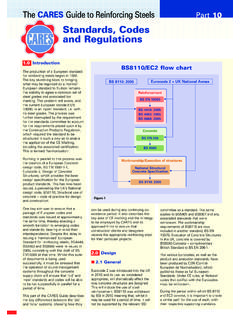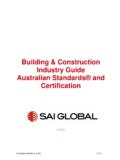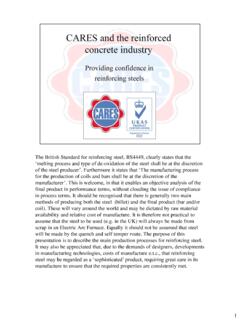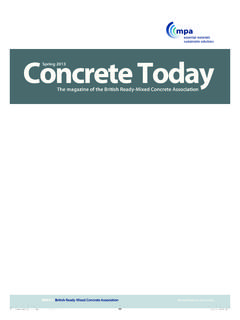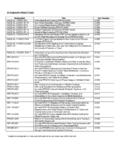Transcription of GRADE 500C REINFORCEMENT - Celsa Steel UK
1 GRADE 500C REINFORCEMENTGUARANTEED DUCTILITYGRADE 500C REINFORCEMENTGUARANTEED DUCTILITYCI/SfB28Eq4 Uniclass P227 September 2005 CELSAINTRODUCTIONDUCTILITY Introduction to ductility The need for ductility in reinforcing steels Defining the ductility of reinforcing steels Comparison of ductility according to Steel gradeCELSA DUKTIL 500 CREINFORCING STEELS Introduction Tensile properties Bend performance Fatigue performance B0nd performance Weldability Mechanical capacities Celsa DUKTIL 500 CREINFORCING BARS Introduction Rib geometry Identification Labelling Test certification Celsa DUKTIL 500 CREINFORCING COILS Introduction Rib geometry Identification Labelling Test certification Advantages of using coiled Celsa Duktil 500 CINDEXINDEXp3p4p11p14p15p1 APPLICATIONS FORCELSA DUKTIL 500C Applications for Celsa Duktil 500C special ductility Steel Advantages of using 500C high ductility steelsAPPENDIX Why we need ductility in reinforced concrete Professor Andrew Beeby,University of Leeds p17p19 INDEXp2 Celsa DUCTILITY: GUARANTEE OF SAFETYCELSA DUCTILITY: GUARANTEE OF SAFETYp3 INTRODUCTIONWhen referring to reinforced concrete,ductility is often regarded as a complexconcept.
2 However, put simply, it refers to abuilding s ability to dissipate energy anddeform without brittle or sudden the Steel bars used for concretereinforcement (rebar), ductility can bedefined as the ability of the bar to deformplastically without fracture, whilstmaintaining its strength. This concept canbe directly related to the non-linearbehaviour of structures in which ductilityplays an important many years engineers have recognisedthat continuous construction ( staticallyindeterminant structures) achieves fargreater load carrying capacity than similarsimple structures (single span staticallydeterminant). This is due to a continuousstructure s ability to transfer potentialoverloading stresses to other less worked regions of the structure via rotation and behaviour can lead to significantdeformation for only a small increase inload.
3 The design of structural elementsperforming in this way goes far beyond therealms of linear elastic testing has been carried out tounderstand this plastic performance only did this prove that the responsewas very different to that theoreticallypredicted, but it led to the development ofa factor for flow or plasticity. In design, thisfactor for flow and plasticity is adopted inthe form of moment 1965 the basic principles of Steel s non-linear behaviour were published in CEBB ulletin No 52. Today the subject is againbeing studied to produce plastic designcalculations based on better understanding,increased computing power and reviseddesign standards. These standards haveincorporated indirect methods of plasticcalculation based on the redistribution ofmoments obtained from elastic should never be forgotten that the ability to take a reinforced concreteelement beyond linear elastic analysis is almost entirely due to the ductility of the Steel structures need ductility, as well asstrength.
4 In reinforced concrete, it is thereinforcing Steel , which provides thestructural element with ductility. Ductility of the element is its ability to fail bydeflection or extensive cracking in anoverload situation, without suddencatastrophic developments in design codes, suchas Eurocode 2 (BS EN 1992-1-1:2004) haverecognised the importance of the ductility ofthe reinforcing Steel . New parameters for thespecification of Steel ductility have beenintroduced, in both Eurocode 2 and inmaterial 2 recognises three differentreinforcing Steel classes (A, B and C), based on ductility. Design rules nowrecognise the importance of Steel ductilityand provide designers with the means ofusing the additional ductility provided byhigh ductility British Standard for reinforcing steels(BS 4449), which will be used inconjunction with the new EuropeanStandard (BS EN 10080), has been revisedto reflect the three ductility classes ofEurocode 2.
5 The characteristic yield strengthhas also been increased from 460 MPa to500 MPa. The three grades introduced in BS 4449:2005 are B500A, B500B and brochure explains the importance ofductility in reinforced concrete structures,and the importance of ductile reinforcingsteels. This is dealt with in some detail inthe Appendix, written by Professor AndrewW. Beeby of Leeds Steel (UK) Ltd, on the basis ofextensive experience in group companies in Spain, has developed new steels for the UK market that fully meet all of therequirements of BS 4449 GRADE B500C. This Steel is called Celsa DUKTIL brochure describes Celsa DUKTIL 500 Csteels, their manufacture and DUKTIL 500C steels, new to the UKmarket, will give designers the ability to usehigh ductility steels, gaining the full designbenefits of Eurocode 2, producing structureswith added robustness and TO DUCTILITYDUCTILITYp5 THE NEED FOR DUCTILITY IN reinforcing STEELSS trength is a characteristic of Steel requiredin calculations, and recognised in standardsand design codes, because Steel plays anintegral role in the mechanical behaviour ofreinforced define strength requirements by means of two parameters.
6 The elasticlimit or yield strength(which is used in the Steel GRADE designation) and theultimate tensile is a necessary requirement but it is not sufficient in itself to define thebehaviour of reinforcing Steel in is also a requirement for is a brittle material, withoutductility, and cannot be used for structuralapplications without REINFORCEMENT . The ductility within a structure, somethingwhich concrete does not have, is providedby the Steel REINFORCEMENT . Therefore thesteel must be sufficiently ductile so thatevery reinforced concrete section, includingstructural elements, has the capacity todeform by an adequate concrete was considered as thelimiting factor for plastic rotation because ofits low level of ductility. In general it wasconsidered that the capacity for plasticrotation was independent of the type ofsteel used, because it was assumed that theconcrete was the limiting factor.
7 The steelwas assumed to have sufficient ductility sothat it did not limit rotation. This presumption was made because at that time Steel had comparatively lowstrength and high ductility owing to itschemical composition and the manufacturingprocesses employed. Later steels withhigher strength and lower ductility wereintroduced, such as cold rolled wire( GRADE A material).The ductility of a Steel is its capacity to deform under load without fracture once the yield strength has been exceededFurther studies have shown that the level ofductility of the Steel influences and limitsthe rotation of plastic addition to the strength and ductilityrequirements, reinforced concrete needssufficient bonding between Steel andconcrete to ensure the composite worksefficiently and cracking is controlled.
8 Ductility is a property of reinforcing steelthat is essential in those applications inwhich structures are subject to unexpectedforces (seismic, dynamic, impact etc). Inthese situations, in which redistribution of moments is envisaged, it is not possible to calculate the loadings preciselyowing to the nature of the loads or because of lack of knowledge about theeffects on the OF MOMENTS ACCORDING TO EUROCODE 2 ELASTIC : low ductility : high ductility steelM + (or )M EC-2In the case of a reinforced concrete structuresubject to earthquakes, its behaviour isclosely related to the ductility of itsreinforcing Steel . In this situation it isessential to know the capacity of thestructure to react to exceptional loads whenthe elastic limit of the Steel is exceeded.
9 Similarly, in those cases where forces andloads are difficult to quantify, it is desirableto design structures that resist loads thatgreatly exceed the generally accepted valuesused for design calculation without collapsedue to deformation or major the structure is brittle, collapseoccurs without prior warning,showing virtually no deformation and without crackingA ductile structure close to collapseshows its condition throughpronounced deformation and crackingOne of the benefits of ductility is the abilityto redistribute loads, dissipating the appliedenergy to flexible elements such as property allows a more efficient use ofconcrete and Steel because the moststressed zones can transfer load to lessstressed redistribution of moments is the ability totransfer negative moments to positive onesand vice versa and is recognised in designcodes (ACI, Eurocode 2, CEB-FIP).
10 Significant redistribution of energy can onlybe achieved if the Steel has high 2 allows the redistribution ofmoments as a function of the ductility classof the ductility class A, redistribution is limitedto 20%, whilst for classes B and C, up to30% redistribution is 2 also allows plastic analysis forbeams, frames and slabs where reinforcingsteels of classes B and C are used. This isnot allowed where class A steels are attention needs to be given to thespecification of reinforcing steels for use inseismic design situations. In this case, thereversal of loading from tension tocompression has a particularly destructiveeffect. Test methods are available whichsimulate seismic actions by subjectingreinforcing Steel samples to cyclic loadingunder hysteresis behaviour of reinforcing Steel undersuch cyclic loading conditions is stronglydependent on ductility.
